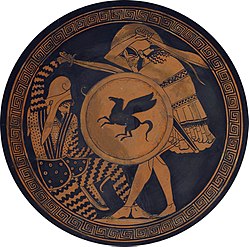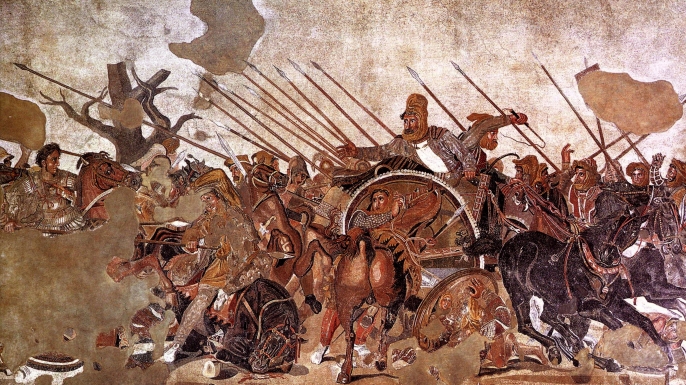Persia – whose core area roughly
corresponds to modern Iran – has a lot to offer for us wargamers intrigued by
history: As early as 900 BC the Medes
have founded the first Persian realm by conquering large areas of the Assyrian kingdom and finally
destroying it.
From about 550 BC the
Achaemenid dynasty was leading the Persian realm as kings (in Persian: Shah). By
conquering Babylonia and Egypt they built the first greater empire known in
history.
At the time of 500 BC the Greeks
in Ionia (Asia Minor) revolted against the Persian rule and thus started the 50
year period of the so called Graeco-Persian Wars.
About 30 greek city states lead by Athens and Sparta finally succeeded to gain or
maintain independence from Persia. Important and known events of this period are
the ground battles of Marathon and
Plataiai and the naval battle of Salamis, as well as the battle at Thermopylae,
which inspired the graphic novel and film “300”.
In 331 BC the Macedonian king
Alexander
invades Persia with a graeco-macedonian army and repeatedly defeats the Persian
Great-king Dareios III. Alexander subsequently conquers the whole empire of
Persia.
After the death of
Alexander in 323 BC his realm disintegrates. Persia is then ruled by Seleukos I
Nikator, a former general and companion of Alexander. Seleukos is founding the
house of the Seleucids which is to rule Persia for the 100 years to come.
The Parthians
From 250 BC to 140 BC the Parthians
– a horse people originating from the Caspian Sea – are conquering the Seleucid
realm east of the river Euphrat bit by bit and are setting up their own rule in
Persia. About 50 BC the Roman empire takes possession of the eastern coast of
the Mediterranean Sea and ventures further east, thus starting a conflict
between the Roman and the Persian empire which is to last for centuries. The
rivals encounter both triumph and defeat while fighting for control of the
regions of Armenia, Transcaucasia and Mesopotamia.
During a period of weakness
of the Parthian rule Ardashir – descendant of Sasan, former governor of the
province of Persis and eponym of the later Sassanid dynasty – takes control of
Persis against his Parthian superiors. Over the course of the following years
Ardashir conquers province after province and in the year 224 AD he defeats the
Parthian king Artabanos V in the battle of Hormozdgan and
puts an end to the Parthian rule of Persia.
The Roman historian Lucius Cassius Dio
describes the rule of Ardashir: “He
prides himself of winning back all the domains who ever had been under Persian
rule – going as far as to the Aegean Sea. He declares it his rightful legacy
handed down from his forefathers.” All the Sassanid leaders will stick to
this ambitious policy for the full 400 years period of their rule.
To the northeast the
Sassanids have to defend against horse people like the Hephtalites from central
Asia, to the west they fight the Romano-Byzantine empire. In both theatres the
Sassanids are seeing both glorious victories – e.g. by capturing or killing the
roman emperors Valerian and Julian – and crushing defeats e.g. with the death
of king Peroz I in the battle of Herat
in 484 AD.
At the outset of the 7th
century AD the Sassanids overrun the Byzantine strongholds in Mesopotamia,
conquer Armenia, invade Anatolia and later occupy Egypt. These huge losses of territory
are a life-threatening blow against the Byzantine empire. Emperor Herakleios thus starts a
counter offensive in 622 AD. With the help of Khazar mercenaries he expulses
the Sassanids from Anatolia and finally invades into Persian core-areas.
This war of conquest and
counter-conquest has weakened both the Byzantine and the Persian empire and it
is a new third party – the muslim arabs - which benefits from their weakness.
In the following 30 years they defeat both armies in several battles, conquer
Syria and invade Persia. In the year 651 AD Yazdagird III the last Sassanid
ruler dies and Persia becomes part of the muslim Rashidun Caliphate.
The DBA army II/69 Sassanid Persian
In DBA the Sassanids are a
very attractive army to have in your collection, because they dispose of no
less than 17 historical opponents and six different allies and thus there are a
lot of options for historical battles to be played. In DBA 2.2 this is the
composition of the Sassanid army:
1x 3Cavalry General
1x 4Knights (Cataphracts) or 3Cavalry
4x 3Cavalry
1x 2Light Horse
1x Elephant or 3Cavalry
1x 3Auxilia or 3Cavarly
2x 7Horde
1x 2Psiloi
The bulk of the army is made up of noble mounted
bowmen, in DBA graded as Cavalry and of heavily armed Cataphracts of the
nobility again. Foot soldiers are of lesser quality and mainly graded as Horde.
There is the possibility to muster one element of Indian war elephants from the
eastern border of the Sassanid empire.
I have been working on miniatures from the
Sassanid Army Pack from Lurkio. The
miniatures’ design is ok as is the quality of their casting. All the mounted
miniatures come in two parts: One part is the horse and the horseman’s legs,
the other part is the horseman’s torso. This way they say you can vary the appearance
of your mounted troops. In fact all torsos (or torsi ?) of the mounted bowmen
come in exactly the same pose, so there is not much variety to gain. I would
prefer a small number of different poses of one-piece mounted figures from the somewhat
laborious procedure of putting the figures together (I have inserted a pin for
better stability).
The Pictures
The Pictures
 |
| Cavalry (3Cv) General |
 |
| heavily armed nobiltiy as Cataphracts (4Kn) |
 |
| mounted bowmen of the nobility (3Cv) |
 |
| mounted bowmen of the nobility (3Cv) |
 |
| mounted bowmen of the nobility (3Cv) |
 |
| the full force of noble mounted bowmen (7x 3Cv) |
 |
| from left to right: Peasantry as slingers (2Ps), trained and equipped footmen (3Ax), light mounted bowmen of lesser nobility (2LH) |
 |
| the bulk of the footmen with spear and leather reinforced wicker shield |
 |
| Indian war elephant |
 |
| the least mobile part of the Sassanid army |
 |
| tomb of a Persian ruler as camp element |
 |
| priest and guards as "camp followers" in terms of DBA |
The camp element is a model
of the existing tomb of Cyrus II, great king of Persia (about 580 – 530 BC).
This model was designed and manufactured by my dear friend Menic, I only had to
paint it up. You can order your own raw copy at Menix
Miniatures. The priest figure is from Xyston Miniatures’ Parthian
King Personality Pack.
 |
| my DBA 2.2 II/69 Sassanid Persian army |
Sources
- Osprey, Rome's enemies 3: Parthians and Sassanid Persians (Men-at-arms series 175), 1986
- Sassanian Armies - The Iranian Empire early 3rd to mid-7th centuries AD, Nicolle & McBride, Montvert Publications, 1996
- Die Wiedergeburt Persiens (Serie Archäologie in Wort und Bild), G.Herrmann, Verlag Kunstkreis Luzern, 1975
- de.m.wikipedia.org/wiki/Geschichte_Irans





Keine Kommentare:
Kommentar veröffentlichen